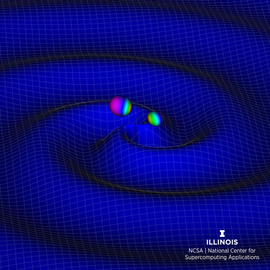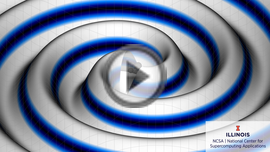Scientists Pioneer Use of Deep Learning for Real-Time Gravitational Wave Discovery |
| |  | | | Blue Waters numerical relativity simulation of two colliding black holes with the open source, numerical relativity software, the Einstein Toolkit. Authors: R. Haas and E. Huerta (NCSA/University of Illinois); Visualization: R. Haas. | | |
Scientists at the National Center for Supercomputing Applications (NCSA), located at the University of Illinois at Urbana-Champaign, have pioneered the use of GPU-accelerated deep learning for rapid detection and characterization of gravitational waves. This new approach will enable astronomers to study gravitational waves using minimal computational resources, reducing time to discovery and increasing the scientific reach of gravitational wave astrophysics. This innovative research was recently published in Physics Letters B.
Combining deep learning algorithms, numerical relativity simulations of black hole mergers––obtained with the Einstein Toolkit run on the Blue Waters supercomputer––and data from the LIGO Open Science Center, NCSA Gravity Group researchers Daniel George and Eliu Huerta produced Deep Filtering, an end-to-end time-series signal processing method. Deep Filtering achieves similar sensitivities and lower errors compared to established gravitational wave detection algorithms, while being far more computationally efficient and more resilient to noise anomalies. The method allows faster than real-time processing of gravitational waves in LIGO’s raw data, and also enables new physics, since it can detect new classes of gravitational wave sources that may go unnoticed with existing detection algorithms. George and Huerta are extending this method to identify in real-time electromagnetic counterparts to gravitational wave events in future LSST data.
NCSA’s Gravity Group leveraged NCSA resources from its Innovative Systems Laboratory, NCSA’s Blue Waters supercomputer, and collaborated with talented interdisciplinary staff at the University of Illinois. Also critical to this research were the GPUs (Tesla P100 and DGX-1) provided by NVIDIA, which enabled an accelerated training of neural networks. Wolfram Research also played an important role, as the Wolfram Language was used in creating this framework for deep learning. |
|
| |  | | | Watch Deep Filtering demo here. | | |
George and Huerta worked with NVIDIA and Wolfram researchers to create this demo to visualize the architecture of Deep Filtering, and to get insights into its neuronal activity during the detection and characterization of real gravitational wave events. This demo highlights all the components of Deep Filtering, exhibiting its detection sensitivity and computational performance.
This work was awarded 1st place at the ACM Student Research Competition at SC17, and also received the Best Poster Award at the 24th IEEE international Conference on HPC, Data, and Analytics. This research was presented as a contributed talk at the 2017 Deep Learning Workshop for the Physical Sciences. |
|
ABOUT THE NATIONAL CENTER FOR SUPERCOMPUTING APPLICATIONS
The National Center for Supercomputing Applications (NCSA) at the University of Illinois at Urbana-Champaign provides supercomputing and advanced digital resources for the nation’s science enterprise. At NCSA, University of Illinois faculty, staff, students, and collaborators from around the globe use advanced digital resources to address research grand challenges for the benefit of science and society. NCSA has been advancing one third of the Fortune 50 for more than 30 years by bringing industry, researchers, and students together to solve grand challenges at rapid speed and scale.
FOR MORE INFORMATION
Kristin Williamson
Senior Assistant Director, NCSA
University of Illinois at Urbana-Champaign
Public Affairs / Marketing / Facilities
Office: 217-300-2933
Cell: 217-343-1594
kwillia8@illinois.edu |
|
|

